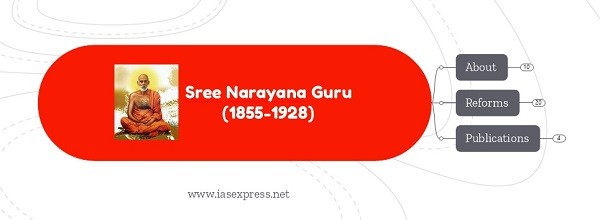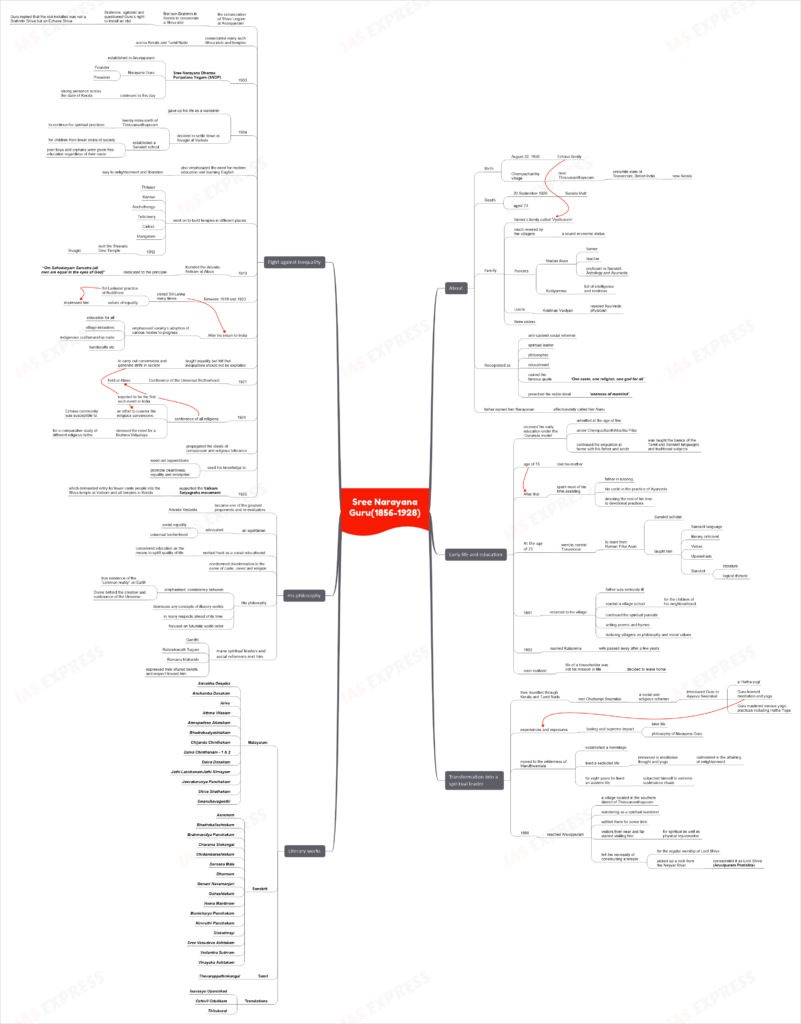Sree Narayana Guru (1856-1928) – Biography, Philosophy, Literary Works

Sree Narayana Guru (1856-1928), was an anti-casteist social reformer, spiritual leader, philosopher, and educationist. He is known for his fight against the caste-ridden social set-up in Kerala. He coined the famous quote – ‘One caste, one religion, one god for all’ and preached the noble ideal of the ‘oneness of mankind’. He devoted most of his life to promoting social equality and emphasised the need for education and spiritual growth for the upliftment of the downtrodden.
Early life and education
- Sree Narayana Guru was born on August 22, 1856, in an Ezhava family in Chempazhanthy village near Thiruvananthapuram in the erstwhile state of Travancore, in British India now Kerala.
- His parents were Madan Asan and Kuttiyamma. Sree Narayana had three sisters. His family was a farmer’s family called ‘Vyallvaram’. Narayana’s father and his family were much revered by the villagers because they also had a sound economic status.
- His father was a farmer, and teacher and was proficient in Sanskrit, Astrology and Ayurveda. His mother was full of intelligence and kindness. His uncle Krishnan Vaidyan was a reputed Ayurvedic physician.
- Narayana Guru’s father named him Narayanan but he affectionately called him Nanu, a short name for Narayanan.
- Narayana received his early education under the ‘Gurukula model’. At the age of five, he was admitted to a neighbouring school under ChempazhanthiMootha Pillai. He also continued his education at home with his father and uncle. He was taught the basics of the Tamil and Sanskrit languages and traditional subjects such as Siddharupam, Balaprobhodhanam and Amarakosam.
- At the age of 15, he lost his mother. After that, he spent most of his time assisting his father in tutoring, and his uncle in the practice of Ayurveda, while devoting the rest of his time to devotional practices.
- When Narayana turned 21, he went to central Travancore to learn from Raman Pillai Asan, a Sanskrit scholar who taught him the Sanskrit language, literary criticism, the Vedas, Upanishads, and the literature and logical rhetoric of Sanskrit.
- In 1881, he returned to his village when his father was seriously ill. He started a village school for the children of his neighbourhood. As he was a teacher, the villagers and children respectfully addressed him as “Nanu Asan”. The term ‘Asan’-a, a Malayalam word derived from Sanskrit, means ‘Acharyan’–a teacher.
- He continued his spiritual pursuits and writing poems and hymns and lecturing villagers on philosophy and moral values simultaneously.
- After a year, in 1882, Narayana Guru married Kaliamma, the daughter of a traditional doctor in his village. His wife passed away after a few years.
- However, he soon realized that the life of a householder was not his mission in life and decided to leave home.
Transformation into a spiritual leader
- He then travelled through Kerala and Tamil Nadu and in the process met Chattampi Swamikal, a social and religious reformer, who introduced Guru to Ayyavu Swamikal from whom he learned meditation and yoga.
- Under Thycattu Ayyaavu, a ‘Hatha yogi’, Narayana Guru mastered various yogic practices including Hatha Yoga. These scholastic experiences and exposures etched a lasting and supreme impact on the later life and philosophy of Narayana Guru.
- Then, Narayan Guru moved to the wilderness of Maruthwamala where he established a hermitage and lived a secluded life immersed in meditative thought and yoga.
- Here, for eight years he lived an austere life and subjected himself to extreme sustenance rituals.
- This secluded life culminated in the attaining of enlightenment by Sree Narayana Guru.
- In 1888, Narayan Guru reached Aruvippuram, a village located in the southern district of Thiruvananthapuram, wandering as a spiritual wanderer.
- He settled there for some time when visitors from near and far started visiting him for spiritual as well as physical rejuvenation.
- He felt the necessity of constructing a temple there for the regular worship of Lord Shiva. Therefore, he picked up a rock from the Neyyar River and consecrated it as Lord Shiva (Aruvipuram Pratishta).
Fight against inequality
- After the consecration of Shiva Lingam at Aruvippuram, people started worshipping it with flowers, camphor, and incense sticks. The Brahmins soon came to know about it and reached the spot agitating and questioning Narayan Guru’s right to install an idol.
- As per tradition, only Brahmins were allowed to install idols in those days. Guru was the first non-Brahmin in Kerala to consecrate a Shiva idol.
- When questioned, Narayan Guru replied that the idol he had installed was not a Brahmin Shiva but an Ezhava Shiva.
- Soon after, he consecrated many such Shiva idols and temples across Kerala and Tamil Nadu.
- In 1903, the Sree Narayana Dharma Paripalana Yogam (SNDP) was established in Aruvippuram with Narayana Guru as the Founder and President. The organisation continues to this day with a strong presence across the state of Kerala.
- In 1904, Guru gave up his life as a wanderer and decided to settle down in Sivagiri at Varkala, twenty miles north of Thiruvananthapuram to continue his spiritual practices.
- In Sivagiri, at Varkala, he established a Sanskrit school for children from lower strata of society. In this school, poor boys and orphans were given free education regardless of their caste.
- He also emphasized the need for modern education and learning English, saying it was the way to enlightenment and liberation.
- He went on to build temples in different places – Thrissur, Kannur, Anchuthengu, Tellicherry, Calicut, and Mangalore. In 1912, he built the Sharada Devi Temple at Sivagiri.
- In 1913, he founded the Advaita Ashram at Aluva which was dedicated to the principle – “Om Sahodaryam Sarvatra (all men are equal in the eyes of God)”.
- Between 1918 and 1923 he visited Sri Lanka many times. The Sri Lankans’ practice of Buddhism and its values of equality impressed him a lot.
- After his return to India, Guru also emphasised society’s adoption of various modes to progress, such as education for all, village industries, indigenous craftsmanship-trade, handicrafts etc.
- Narayana Guru taught equality but felt that inequalities should not be exploited to carry out conversions and therefore generate strife in society.
- In 1921, a Conference of the Universal Brotherhood was held at Aluva and in 1924 a conference of all religions was held there. It was reported to be the first such event in India.
- The 1924 conference was an effort to counter the religious conversions the Ezhava community was susceptible to.
- Narayana Guru stressed the need for a Brahma Vidyalaya for a comparative study of different religious faiths.
- He propagated the ideals of compassion and religious tolerance. He also used his knowledge to weed out superstitions and promote cleanliness, equality and enterprise.
- In 1925, Narayana Guru supported the famous Vaikom Satyagraha movement, which demanded entry for lower caste people into the Shiva temple at Vaikom and all temples in Kerala.
His philosophy
- Sree Narayana Guru became one of the greatest proponents and re-evaluators of Advaita Vedanta, the principle of non-duality put forward by Adi Shankara.
- He was also an egalitarian who advocated social equality and universal brotherhood. He worked hard as a social educationist and condemned discrimination in the name of caste, creed and religion. He considered education as the means to uplift his/her quality of life.
- His philosophy emphasised the consistency between the true existence of the “common reality” on Earth and one Divine behind the creation and sustenance of the Universe, dismissing any concepts of illusory worlds.
- Narayana Guru’s philosophy was in many respects ahead of its time and focused on futuristic world order. People like Gandhi, Rabindranath Tagore, Ramana Maharshi, and many social reformers and spiritual leaders met him and expressed their shared beliefs and respect toward him.
Death
- In 1928, there was a severe deterioration in Guru’s health and he remained bedridden for some months.
- On 20 September 1928, at the age of 73, Narayan Guru breathed his last at Sarada Mutt.
Literary works
His works were written in Malayalam, Sanskrit and Tamil.
- In Malayalam
- Advaitha Deepika
- Anukamba Dasakam
- Arivu
- Athma Vilasam
- Atmopadesa Åšatakam
- Bhadrakaalyashtakam
- Chijanda Chinthakam
- Daiva Chinthanam – 1 & 2
- Daiva Dasakam
- Jathi LakshanamJathi Nirnayam
- Jeevakarunya Panchakam
- Shiva Shathakam
- Swanubavageethi
- In Sanskrit
- Asramam
- Bhadrakaliashtakam
- Brahmavidya Panchakam
- Charama Slokangal
- Chidambarashtakam
- Darsana Mala
- Dharmam
- Genani Navamanjari
- Guhashtakam
- Homa Manthram
- Municharya Panchakam
- Nirvruthi Panchakam
- Slokathrayi
- Sree Vasudeva Ashtakam
- Vedantha Suthram
- Vinayaka Ashtakam
- In Tamil
- Thevarappathinkangal
- Translations
- Isavasyo Upanishad
- Ozhivil Odukkam
- Thirukural


